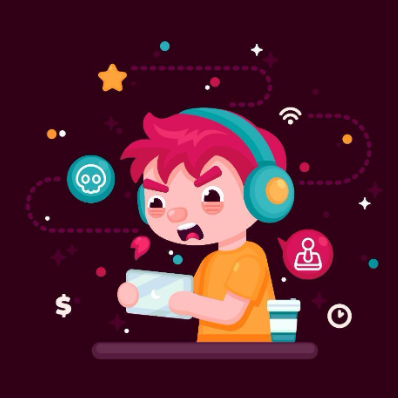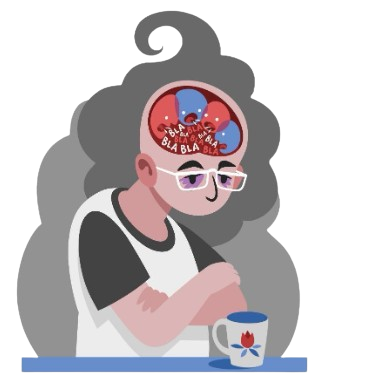
Module 6 : Délimiter les usages bénéfiques et problématiques des écrans en fonction de l'âge des apprenants

Objectif du module
L'objectif de ce module d'apprentissage est de couvrir un large éventail de compétences et de connaissances nécessaires aux enseignants et aux formateurs sur les utilisations bénéfiques et problématiques des écrans en fonction de l'âge des apprenants. Nous examinerons comment les différents groupes d'âge utilisent les médias numériques et en quoi ils sont bons ou mauvais pour eux.
Résultats d'apprentissage
À l'issue de ce module, les apprenants auront acquis les connaissances et les compétences nécessaires pour comprendre comment les médias numériques affectent les différents groupes d'âge, comme indiqué ci-dessous:
Connaissances
- a. Pourquoi un temps d'écran excessif peut être néfaste pour les jeunes enfants .
- Comprendre comment les jeunes enfants peuvent être affectés négativement par les médias numériques.
- Comment le temps passé devant l'écran peut affecter les enfants plus âgés, les jeunes et les adultes
- Comprendre comment le cerveau régule la dépendance
- Comprendre et analyser la manière dont les différents groupes d'âge utilisent les médias numériques
- Comprendre comment certains individus peuvent être plus vulnérables que d'autres aux effets des appareils numériques.
- Comment le temps passé devant l'écran peut être problématique ou bénéfique
- Comprendre comment éviter la dépendance à l'internet ou aux jeux vidéo
- Comprendre l'utilisation des boîtes à butin par les enfants
Compétences
Identifier les types de dispositifs numériques qui peuvent être bénéfiques ou problématiques pour les jeunes
- Analyser comment réduire son propre temps d'écran
- Soutenir un développement équilibré et réduire la dépendance aux appareils numériques pendant les loisirs
Liste des thèmes
Les recherches montrent que l'utilisation des écrans a un effet négatif important sur le développement du cerveau des enfants de moins de 3 ans, entraînant un moins bon développement de la matière blanche du cerveau. L'Organisation mondiale de la santé recommande que les enfants âgés de 3 à 5 ans utilisent les écrans sans accompagnement pendant une heure maximum par jour, et que les enfants de moins de 3 ans utilisent les écrans le moins possible. La recherche clinique indique que l'interaction en face à face est beaucoup plus bénéfique pour l'apprentissage et le développement des jeunes enfants. Les leaders technologiques de la Silicon Valley envoient souvent leurs enfants dans des écoles qui utilisent peu de technologie et qui mettent l'accent sur la créativité et les activités pratiques. Il est essentiel que les parents s'engagent directement avec leurs enfants, car les appareils numériques ne peuvent pas leur apporter le soutien émotionnel et développemental nécessaire.
L'utilisation excessive d'écrans chez les enfants plus âgés et les jeunes peut conduire à la dépression, à l'anxiété et à l'agressivité, ce qui est similaire aux effets des drogues addictives. Un temps d'écran excessif peut provoquer des réactions de type psychotique. Les différences entre les sexes montrent que les filles sont plus affectées par les médias sociaux, ce qui entraîne des taux plus élevés d'insécurité et d'anxiété sociale. La recherche n'indique pas de lien direct entre les jeux violents et la violence dans la vie réelle, mais l'addiction aux jeux est reconnue par l'OMS comme un grave problème de santé. Les mesures préventives comprennent l'implication des parents et l'apprentissage de la maîtrise de soi afin d'atténuer les risques d'addiction.
Les adultes sont de plus en plus confrontés à des problèmes d'addiction aux écrans, en particulier à l'utilisation du téléphone portable, qui est souvent liée à l'ennui et à l'incapacité de s'activer. Une grande partie des adultes, en particulier les parents et les jeunes, se sentent coupables du temps qu'ils passent en ligne. Les recherches montrent que de nombreux adultes préfèrent être mal à l'aise plutôt que d'être seuls avec leurs pensées, comme le montre une étude où les participants ont choisi de rechercher la stabilité et d'éviter l'incertitude, même si cela signifie rester dans des situations inconfortables. L'addiction au jeu est également répandue chez les adultes, en particulier dans certains groupes démographiques, et elle est souvent utilisée comme mécanisme d'adaptation au stress et aux problèmes financiers ou à l'isolement social. Le système de récompense du cerveau change avec l'addiction, ce qui rend difficile la distinction entre le bien et le mal et accroît le besoin d'adopter d'autres comportements addictifs pour atteindre l'épanouissement et la satisfaction.
Objectif, concepts clés, compétences à développer
À l’issue de ce module, vous serez capable de :
- Comprendre comment les médias numériques peuvent être nocifs pour votre santé et pourquoi
- Comment les appareils numériques affectent les différents groupes d'âge
- Apprendre des méthodes d'adaptation pour permettre aux jeunes de réfléchir à leur propre utilisation du temps d'écran
Guide d'apprentissage
Pour optimiser le matériel pédagogique de ce module, commencez par comprendre comment la dopamine affecte le cerveau et pourquoi elle peut être nocive, en particulier pour les jeunes enfants.
Pour améliorer les capacités d'apprentissage, participez aux discussions et aux activités de collaboration, explorez les liens fournis pour approfondir vos connaissances et, après chaque section, réfléchissez à la manière de mettre en pratique ce que vous avez appris.
Étude de cas motivant
Jay a 16 ans. Il a un examen de mathématiques demain et étudie dans sa chambre. Il s'agit d'un sujet avancé, il doit donc se concentrer. Le téléphone sonne, il vérifie, c'est une alerte d'un jeu. Il éteint le son. Cela ne fera que perturber sa concentration. Il parvient à résoudre une équation et en est très heureux. Il a envie de se récompenser en jouant, mais il y résiste. Il lui reste encore beaucoup d'équations à résoudre. Mais il est difficile de se concentrer sur les mathématiques. Il se promet de terminer toutes les équations avant de pouvoir jouer. Il se rend donc dans la cuisine, où il n'y a pas d'ordinateur, et laisse son téléphone derrière lui.
La recherche montre que vous pouvez mieux vous concentrer si vous n'êtes pas près de votre téléphone parce que les humains apprennent à prêter automatiquement attention aux choses qui sont habituellement pertinentes pour eux, même lorsqu'ils sont concentrés sur une autre tâche.
Grâce à ce module de formation, les formateurs apprendront comment donner aux élèves comme Jay les moyens de faire de meilleurs choix. Équipés de ces compétences, les jeunes apprenants auront un meilleur contrôle sur leur utilisation du temps d'écran.
Thème 1 - Pourquoi les écrans sont particulièrement problématiques pour les jeunes enfants

Il y a lieu de s'inquiéter lorsque ceux qui sont les plus vigilants quant à l'utilisation des écrans par leurs enfants sont les leaders du secteur technologique. Le fondateur d'Apple, Steve Jobs, était connu pour ses règles strictes en matière d'enfants et de technologie. Plusieurs dirigeants et ingénieurs de la Silicon Valley envoient leurs enfants dans des écoles qui utilisent délibérément peu de technologies, telles que la Waldorf School of the Peninsula / Steiner Education. Il est à noter que 75 % des enfants qui fréquentent ces écoles ont des parents qui travaillent dans le secteur des technologies. Les enfants des fondateurs de Google, Sergey Brin et Larry Page, ont fréquenté des écoles Montessori. Le fondateur d'Amazon, Jeff Bezos, et le fondateur de Wikipédia, Jimmy Wales, ont tous deux suivi leur scolarité primaire dans des écoles Montessori. Ces écoles ont une pédagogie plus axée sur les arts et stimule la créativité des enfants. Ils doivent apprendre à jouer d'un instrument, ils travaillent à la création d'objets d'art, par exemple en sculptant, en tricotant et en peignant, afin de développer leur motricité fine. Ces écoles privilégient les jeux plutôt que les sports de compétition, et l'utilisation des technologies est très limitée. Alors que l'éducation Montessori encourage la curiosité naturelle en mettant l'accent sur l'apprentissage autonome, l'enseignement Waldorf privilégie le développement holistique par la créativité et l'imagination.
Les journaux publient régulièrement des articles affirmant que l'utilisation des écrans par les jeunes enfants est néfaste, et c'est effectivement le cas. La recherche montre qu'elle a un effet particulièrement négatif sur le développement du cerveau des enfants de moins de trois ans. Des études cliniques ont montré que l'utilisation des écrans entraînait un développement plus lent de la matière blanche du cerveau, la partie du cerveau utilisée pour les processus cognitifs et le développement du langage. Ce phénomène a été mis en évidence en scannant le cerveau des enfants..
L'Organisation mondiale de la santé (OMS) recommande que les enfants âgés de 3 à 5 ans n'utilisent les écrans sans accompagnement que pendant une heure par jour au maximum. Les enfants de moins de cinq ans devraient utiliser les écrans le moins possible. De nombreux parents pensent que les nouvelles technologies sont éducatives pour les enfants. Mais la recherche clinique montre que les enfants de moins de trois ans ont besoin d'une interaction en face à face. Un temps d'écran excessif nuit au sommeil et au développement du langage. L'article suivant, paru sur CNN, met en lumière de nouvelles recherches sur ce sujet:
Le jeu et la communication verbale avec les jeunes enfants sont essentiels à leur développement émotionnel. Au cours des premières étapes de la vie, les enfants dépendent de l'interaction humaine directe. L'expression faciale et les réponses émotionnelles leur montrent comment donner un sens au monde qui les entoure. Les jeunes enfants ont besoin de se sentir reconnus et soutenus émotionnellement. Contrairement aux appareils numériques, les personnes qui s'occupent d'eux fournissent des signaux non verbaux essentiels tels que des sourires, des câlins et de la chaleur.
Si certains jeux numériques peuvent avoir une valeur éducative et divertissante pour les jeunes enfants, leur développement peut bénéficier d'un jeu avec un adulte attentif. Notamment, les enfants de deux ans ont une capacité intuitive à s'engager dans les technologies numériques, y compris les jeux informatiques.
Ressources
Vous trouverez ci-dessous des informations sur les contrôles parentaux pour aider les enfants à utiliser Internet.
Exercice pratique:
Recherchez pourquoi il est bon d'avoir une bonne motricité fine à l'aide d'un moteur de recherche approprié. Rédigez une liste de 5 points pertinents.
Discutez en groupe ou réfléchissez :
Quels types de professions nécessitent une motricité fine ?
Thème 2 – Comment les écrans affectent les enfants plus âgés et les adolescents

Le temps excessif passé devant les écrans affecte également les enfants plus âgés. Dans ce chapitre, vous découvrirez comment l'utilisation excessive des écrans peut affecter les enfants plus âgés et les adolescents, et comment elle peut être comparée à des drogues addictives telles que la nicotine et les stupéfiants.
Une pratique excessive des jeux vidéo peut être associée à divers effets psychologiques négatifs, notamment des symptômes de dépression, mais il est important de reconnaître que, dans certaines circonstances, chez certains adolescents, le jeu excessif peut être une habitude ou un mécanisme d'adaptation. Des études ont montré que l'activité cérébrale des enfants qui jouent pendant de longues périodes est similaire à celle observée chez les personnes sous l'influence de substances addictives. Il convient de noter que les réactions comportementales à la suppression des appareils numériques chez certains chez les enfants, cela inclut les crises de colère et l'agressivité, qui sont des symptômes similaires à ceux observés chez les personnes souffrant d'addictions.
Johann Hari a écrit un livre à ce sujet. Il explique que notre cerveau ne peut produire qu'une ou deux pensées conscientes à la fois. Nos capacités cognitives sont limitées. Mais nous avons été trompés. Aujourd'hui, l'adolescent moyen pense pouvoir suivre six médias en même temps. Lorsque des neuroscientifiques ont étudié ce phénomène, ils ont découvert que lorsque les gens pensent faire plusieurs choses à la fois, ils ne font en réalité que jongler entre différentes tâches. Ils passent de l'une à l'autre. Ils ne remarquent pas ce changement, car leur cerveau le masque en quelque sorte pour leur offrir une expérience consciente fluide, mais ce qu'ils font, c'est changer et reconfigurer leur cerveau à chaque instant, d'une tâche à l'autre, et cela a un coût. Imaginez que vous faites vos devoirs de mathématiques et que vous recevez un SMS. Vous le regardez – cela ne prend que trois secondes – puis vous retournez à vos devoirs. À ce moment-là, votre cerveau doit se reconfigurer pour passer d'une tâche à l'autre. Vous devez vous souvenir de ce que vous faisiez avant l'interruption et vous devez vous souvenir de ce que vous pensiez à ce sujet. Lorsque cela se produit, il est prouvé que vos performances diminuent. Vos réactions sont plus lentes.
C'est ce qu'on appelle « l'effet de coût de commutation ». Cela signifie que si vous consultez vos SMS pendant que vous essayez de travailler, vous ne perdez pas seulement le peu de temps que vous passez à lire les messages, mais aussi le temps nécessaire pour vous reconcentrer ensuite.
Par exemple, une étude menée au laboratoire d'interaction homme-machine de l'université Carnegie Mellon a demandé à 136 étudiants de passer un test. Certains d'entre eux devaient éteindre leur téléphone, tandis que d'autres pouvaient le garder allumé et recevaient des SMS de manière intermittente. Les étudiants qui ont reçu des messages ont obtenu des résultats en moyenne 20 % moins bons. Compte tenu des interruptions constantes auxquelles nous sommes confrontés dans la société actuelle, cela pourrait indiquer que presque tout le monde perd actuellement 20 % de ses capacités cérébrales la plupart du temps...
Des centaines d'études cliniques montrent qu'une utilisation excessive des écrans peut entraîner dépression, anxiété et agressivité, ce qui conduit à des réactions de type psychotique lorsque les joueurs perdent pied avec la réalité. Dans l'article ci-dessous, une psychologue raconte qu'au cours des six derniers mois, elle a rencontré cinq jeunes qui ont commencé à voir et à entendre des choses qui n'existaient pas. Pour se débarrasser de cette addiction, il faut arrêter complètement l'activité qui la provoque pendant deux à six semaines, selon la vitesse à laquelle le cerveau de la personne s'adapte à une vie sans écran.
Le Dr Nicholas Kardaras, auteur de Glow Kids : How Screen Addiction Is Hijacking Our Kids’ Brains (Les enfants rayonnants : comment l'addiction aux écrans détourne le cerveau de nos enfants), explique qu'il a travaillé avec plus de 1 000 adolescents au cours des 15 dernières années. Il affirme que le plus important est la prévention, car lorsqu'un jeune devient accro à la technologie, il est difficile de le soigner.
https://nypost.com/2016/08/27/its-digital-heroin-how-screens-turn-kids-into-psychotic-junkies/?fbclid=IwAR36Ho-BPtefNpWuXaKJDrFTpxAiKATzE4cAhmV0JdYO-bNUgnyGM9zXlKs
Les recherches indiquent que les garçons ont tendance à jouer plus souvent aux jeux vidéo, tandis que les filles passent plus de temps sur les réseaux sociaux. Les adolescentes sont deux fois plus susceptibles que les garçons de présenter des symptômes dépressifs liés aux réseaux sociaux. Ces symptômes sont principalement liés à des expériences de cyberharcèlement, à des troubles du sommeil, à une image négative de leur corps et à une faible estime de soi. Une étude britannique portant sur 11 000 jeunes a montré que les filles de 14 ans utilisaient les réseaux sociaux plus fréquemment que les garçons. Il y a également un pourcentage plus élevé de filles qui utilisent les réseaux sociaux pendant plus de trois heures par jour, par rapport aux garçons.
Cliquez sur le lien ci-dessous pour plus d'informations.
Il existe une perception courante selon laquelle les jeux vidéo violents peuvent entraîner une augmentation de l'agressivité chez les enfants. Cependant, à ce jour, aucune étude n'a démontré de corrélation entre les jeux vidéo violents et la violence dans la vie réelle. Une analyse approfondie des statistiques américaines relatives à la violence et aux jeux vidéo ne montre aucune corrélation. Elle examine la corrélation entre la violence et l'introduction de jeux violents, et les statistiques montrent plutôt l'effet inverse. Les jeux vidéo ont conduit à une diminution de la violence. Cependant, les chercheurs précisent qu'ils ne veulent pas exclure la possibilité que, dans certaines situations, certains individus puissent être affectés, mais cela n'a pas fait l'objet de recherches suffisantes.
Lisez cet article publié sur Researchgate
Des recherches américaines ont montré que bon nombre des jeunes impliqués dans des fusillades scolaires très médiatisées manifestaient peu d'intérêt pour les jeux vidéo violents. Seuls 20 % d'entre eux jouaient à des jeux violents, contre 70 % des autres élèves.
Lisez cet article sur Business insider concernant l’effet psychologique es jeux vidéos
Le jeu en réalité augmentée Pokémon GO a initialement suscité un intérêt positif, car il encourageait les joueurs à sortir de chez eux et à faire de l'exercice physique en plein air tout en recherchant des personnages virtuels. Cependant, au fil du temps, des inquiétudes ont émergé concernant ses conséquences sociales imprévues. Des incidents violents et conflictuels ont été signalés, impliquant non seulement des enfants, mais aussi des adultes. De plus, des cas ont été documentés d'activités criminelles, les voleurs ciblant les zones fortement peuplées par des personnages du jeu afin de voler les joueurs peu méfiants. Des rapports ont également fait état de conducteurs distraits, concentrés sur le jeu au volant, ce qui a failli provoquer des accidents dans des « zones Pokémon ».
L'Organisation mondiale de la santé (OMS) a proposé en 2018 que la dépendance aux jeux vidéo soit reconnue comme un trouble officiel dans le DSM-V (Manuel diagnostique et statistique des troubles mentaux, cinquième édition), et en 2019, cette proposition a été adoptée par la majorité des États membres. Le diagnostic est entré en vigueur le 1er janvier 2022. Pour être diagnostiqué comme dépendant aux jeux vidéo, les trois critères suivants doivent être remplis pendant une période d'au moins 12 mois:
- Manque de contrôle sur le jeu, par exemple en termes de fréquence, d'intensité, de durée et de capacité à s'arrêter
- Le jeu passe avant les autres activités et centres d'intérêt normaux de la vie
- Le jeu se poursuit ou s'intensifie malgré les conséquences négatives et affecte de manière négative les activités quotidiennes normales telles que l'école/le travail, la vie familiale et la vie sociale
On estime qu'environ 3 % des individus répondent aux critères diagnostiques de la dépendance au jeu, la majorité étant des hommes. Cependant, comme le trouble du jeu n'a été reconnu que récemment comme un diagnostic officiel, les recherches approfondies dans ce domaine restent limitées.
Si de nombreux jeunes jouent à des jeux vidéo, ce comportement peut être qualifié plus généralement d' excessif ou, dans certains cas, d'addictif.
Les signes qui peuvent indiquer qu'une personne est dépendante aux jeux vidéo sont les suivants:
Pensées constantes liées aux activités sur Internet, même lorsque vous devriez étudier, travailler ou passer du temps avec votre famille
Symptômes psychosomatiques lorsque vous n'avez pas accès à Internet
Problèmes de maîtrise de soi
Utilisation excessive d'Internet au point de perturber la vie quotidienne
Absence d'intérêt pour d'autres activités ou relations avec d'autres personnes.
Une autre forme d'addiction est le FOMO, ou « fear of missing out » (peur de passer à côté). La peur de passer à côté de ce qui se passe est un type d'addiction à Internet qui est apparu vers l'an 2000. Ce type d'addiction est largement défini et couvre de nombreux types de médias, tels que les achats en ligne, le sexe virtuel et la pornographie, les jeux, les réseaux sociaux, les jeux d'argent en ligne, c'est-à-dire tout ce qui provoque une stimulation.
Ce type de dépendance n'est pas une « véritable dépendance » comme la dépendance au jeu ou aux jeux vidéo, car elle ne présente pas les symptômes qui définissent une dépendance. Cependant, elle peut tout de même entraîner des problèmes psychologiques tels que la dépression et l'anxiété, car vous avez l'impression que votre vie est un échec.
Vous vous reconnaissez dans cette catégorie ? Pour en savoir plus sur la peur de passer à côté, consultez la rubrique « Ressources » de cette rubrique.
Boîtes à butin et addiction aux jeux vidéo
Une loot box est essentiellement un pack de jeu que vous achetez sans connaître son contenu. Une sorte de boîte mystère. Dans certains jeux, ces boîtes vous permettent d'améliorer vos performances en tant que joueur. Par exemple, dans les jeux FIFA, les loot boxes peuvent contenir des joueurs de grande valeur, mais le problème réside dans le fait que vous ne savez pas à l'avance quels joueurs vous allez recevoir, ce qui introduit un élément de hasard similaire à celui des jeux d'argent.
Dans Counter Strike, la boîte fonctionne de la même manière, mais l'expérience des joueurs qui ont acheté de telles boîtes montre qu'il n'y a que deux à quatre bonnes armes sur un total de 10 000 boîtes, donc cette boîte sera également un pari.
De plus en plus de jeux sont gratuits, donc la manière dont l'entreprise gagne de l'argent est que quelqu'un achète ces boîtes mystères. Cela s'appelle « payer pour gagner », car vous pouvez augmenter vos chances de gagner en payant.
Clash royale, une application sur téléphone, est un exemple de ce type de jeu. Lorsque vous achetez un pass royal, les prix sont meilleurs, mais vous devez toujours jouer pour les gagner. Vous pouvez également acheter des coffres dont vous connaissez approximativement le contenu.
Dans Fortnite, la boîte s'appelle Battle pass. Vous y obtenez des vêtements, des skins et des danses qui vous rendent un peu plus « cool ». Mais vous ne devenez pas meilleur. Comme ce sont souvent ces boîtes à butin qui permettent à l'entreprise qui a créé le jeu de le monétiser, vous pouvez être sûr qu'il sera très difficile de gagner.
Une nouvelle étude britannique montre que 93 % des enfants jouent à des jeux vidéo et que 40 % d'entre eux achètent des boîtes mystères.
Les jeunes hommes constituent un public cible typique. Des études ont montré que les garçons plus jeunes et moins éduqués sont plus susceptibles d'en faire un usage excessif. Malheureusement, les acheteurs types sont souvent ceux qui ont le moins les moyens d'acheter, ce qui peut poser un problème d'endettement.
Le rapport de recherche conclut que ces boîtes mystères fonctionnent de la même manière que les jeux d'argent et peuvent donc être tout aussi addictives. Le Japon, la Belgique et les Pays-Bas font partie des pays qui ont interdit ces boîtes mystères.
Que pouvez-vous faire pour éviter de devenir accro ?
- Limitez le nombre de boîtes mystères que vous pouvez acheter chaque semaine.
- Si vous achetez une fois, assurez-vous que votre carte de crédit n'est pas enregistrée dans le jeu afin de ne pas pouvoir en acheter facilement d'autres.
- Rappelez-vous que les chances d'obtenir les meilleures boîtes contenant des objets de valeur sont minces.
- N'oubliez pas qu'il ne s'agit que d'un jeu, n'ayez pas peur de passer à côté, FOMO (fear of missing out).
Quels sont les facteurs de protection contre la dépendance ?
Heureusement, il existe des facteurs de protection qui peuvent prévenir la dépendance. Il est important que les parents connaissent ces facteurs de protection afin d'aider leurs enfants à rester en sécurité en ligne.
Les recherches mettent en évidence les facteurs de protection suivants :
- L'âge de la première exposition à la technologie. Plus une personne est jeune, moins elle est capable de réfléchir de manière rationnelle à l'intérêt d'utiliser la technologie. Malheureusement, de nombreux enfants sont exposés très tôt aux jeux vidéo, et plus ils sont jeunes, plus ils sont susceptibles de développer une addiction.
- L'implication des parents est importante, car elle permet aux personnes qui s'occupent des enfants de les accompagner et de les guider dans leurs activités numériques, tout en les aidant à surveiller leur utilisation.
- La maîtrise de soi et la maîtrise de soi sont des traits de caractère importants à acquérir lors de l'utilisation des technologies, et ces traits peuvent être transmis aux enfants.
- La disponibilité de l'activité. Plus les appareils sont accessibles, plus il est facile de devenir dépendant.
Qui est sujet à la dépendance ?
Certaines personnes sont-elles plus enclines à la dépendance que d'autres ? Qui devient dépendant ? Les recherches du Dr Kevin McCauley montrent que certains facteurs influencent la dépendance :
- Le choix (motivation, compréhension de ce qui crée la dépendance et capacité à réguler ses propres activités)
- Le stress (les personnes exposées au stress sont plus facilement affectées, qu'il s'agisse de conflits familiaux, amicaux ou scolaires)
- Les souvenirs (les expériences positives associées à une substance ou à une expérience positive facilitent la répétition. Les souvenirs contiennent également des déclencheurs qui provoquent des symptômes de sevrage lorsque vous voyez un PC, par exemple)
- Récompense (l'intensité de votre dépendance à la récompense dépend de la tolérance que vous avez développée à son égard : plus vous en avez l'expérience, plus vous en avez besoin)
- Des études sur des jumeaux montrent que 40 à 60 % de la vulnérabilité est liée aux gènes, mais la manière dont vous renforcez les habitudes par votre comportement joue un rôle important.
Nous constatons que les enfants qui ont des problèmes à la maison, par exemple des parents qui se disputent beaucoup, qui n'ont pas d'amis ou qui ont des difficultés à l'école, se réfugient parfois dans le monde des jeux. Dans ce monde, ils vivent des expériences positives qui les poussent à préférer cet univers à la vie réelle. Il est donc important d'examiner la situation globale des jeunes qui jouent beaucoup. Que pouvez-vous faire pour les aider à mieux gérer leur vie ? Peut-être pourraient-ils commencer un sport qui leur permettrait de se faire des amis et de maîtriser de nouvelles activités, ou obtenir de l'aide pour leurs devoirs ?
Cependant, la dépendance aux jeux vidéo n'est pas uniquement influencée par des traits de caractère individuels. L'industrie du jeu vidéo conçoit intentionnellement des jeux utilisant des formats psychologiques visant à maximiser l'engagement des utilisateurs, ce qui peut contribuer à des comportements addictifs. L'un des facteurs propres aux jeux vidéo est que les joueurs obtiennent rapidement un retour d'information. Cela provoque une réponse positive du cerveau et la libération de dopamine dans le système, ce qui procure une sensation de bien-être. Des recherches montrent que le fait de gagner des récompenses peut également avoir un effet sur l'humeur des joueurs. Il existe de nombreux types de récompenses, dont voici quelques exemples.
La comparaison sociale peut augmenter la motivation, mais dans certains jeux, vous pouvez également rivaliser avec vous-même.
Contrôle : les joueurs aiment avoir le contrôle de leurs actions. Si un jeu tente de trop vous contrôler ou limite vos choix, vous risquez d'être frustré et d'arrêter de jouer.
Lumière, graphisme et son peuvent également entraîner une addiction, car ils stimulent le cerveau comme un système de récompense.
Éviter les pertes peut être plus important que de travailler pour gagner plus de prix, car l'aversion du cerveau pour la perte est souvent plus forte que l'envie de gagner.
Ressources
Pour en savoir plus sur la peur de passer à côté, consultez la rubrique « Ressources» ici :
Pour en savoir plus sur les adolescentes et la dépression, cliquez ici.:
Pour en savoir plus sur les recommandations relatives au temps passé devant les écrans dans différents pays européens :
Pour en savoir plus sur le point de vue de l'alliance européenne pour la santé publique sur le temps passé devant les écrans :
Lisez cet article publié sur Researchgate qui explique pourquoi les jeux violents et le jeu vidéo ne sont PAS liés.
Lisez cet article sur Business insider concernant l’effet psychologique es jeux vidéos

Exercice pratique
Tâche individuelle : Posez-vous la question, et soyez honnête :
- Combien de temps passez-vous sur les réseaux sociaux ? Vérifiez votre téléphone.
- Avez-vous déjà reporté quelque chose parce que vous étiez sur votre téléphone ?
- Que pouvez-vous faire à la place d'être sur les réseaux sociaux ? Qu'aimez-vous faire ?
Discussion de groupe et brainstorming: Que pouvez-vous faire pour éviter de passer trop de temps sur les médias numériques ?

Thème 3 – Comment les écrans affectent les adultes
Les adultes et la technologie
Bien que les jeux vidéo soient plus courants chez les jeunes, le nombre d'adultes qui y jouent augmente régulièrement. Cela s'explique en partie par le fait que les jeux vidéo existent depuis suffisamment longtemps pour que les personnes âgées de 40 à 50 ans aient grandi avec eux. De nombreux adultes déclarent se sentir coupables ou insatisfaits du temps qu'ils passent sur leurs appareils mobiles. Respons Analyse a mené une enquête pour VG, un journal norvégien, en 2018 auprès de 1 000 participants, qui montre que près de la moitié des personnes interrogées ont un sentiment négatif à l'égard de leur utilisation du téléphone portable. Ceux qui admettent être dépendants de leur téléphone portable sont des parents ayant des enfants de moins de 16 ans et des jeunes de moins de 30 ans[F1] . Pour approfondir le sujet, consultez le lien ci-dessous.
La dépendance aux jeux vidéo et aux appareils numériques est souvent liée à une incapacité à supporter l'ennui ou à un manque de stimulation personnelle. En 2014, l'université de Virginie a mené une étude qui a montré que les étudiants pouvaient développer une dépendance à des sources externes pour combler ce vide. Mais les chercheurs sont allés plus loin en observant le comportement des adultes lorsqu'on leur donnait le choix entre ne rien faire et utiliser la technologie. 67 % des hommes et 20 % des femmes ont préféré jouer à des jeux vidéo.
Les adultes et les jeux d'argent
64 % de la population norvégienne âgée de 16 à 74 ans a joué au moins une fois à un jeu d'argent au cours des 12 derniers mois, soit 2,5 millions de personnes. Pour ceux qui ne sont pas dépendants au jeu, il peut sembler facile d'arrêter. Pour ceux qui développent une dépendance, arrêter peut être extrêmement difficile en raison des puissantes dépendances psychologiques et comportementales qui entrent en jeu.
L'université de Bergen a publié en 2020 une enquête montrant le type de personnes pouvant être classées comme ayant des tendances à la dépendance.
- les hommes
- les célibataires
- les personnes qui s'occupent d'un ou deux enfants vivant à la maison
- les personnes ayant un faible niveau d'éducation et de revenus
- les personnes handicapées, sans emploi, en réadaptation, etc.
- les personnes nées en Asie, en Afrique, en Amérique du Sud ou en Amérique centrale
Ces personnes ont un pourcentage plus élevé de devenir des joueurs compulsifs. Le jeu peut être une activité amusante si l'on ne devient pas dépendant. La plupart des gens qui jouent le font pour s'amuser ou pour gagner. Mais ceux qui deviennent dépendants ont également d'autres raisons de jouer qui peuvent sembler déraisonnables à ceux qui ne le deviennent pas. Ce qui est intéressant, c'est que les joueurs compulsifs jouent également pour oublier leurs problèmes. Cela leur procure une sensation d'euphorie et ils ont l'impression de pouvoir jouer pour compenser leurs pertes précédentes.
Lorsqu'une personne vit une expérience positive en jouant, votre cerveau libère une substance appelée dopamine qui vous procure une sensation de bonheur. La dopamine est un neurotransmetteur qui, entre autres, produit une sensation de plaisir, d'anticipation du plaisir, de motivation et de récompense. Comme vous souhaitez revivre cette sensation agréable, vous avez envie de jouer de plus en plus. Ainsi, cette partie du cerveau est activée plus rapidement que le lobe frontal, qui est votre cerveau logique, de sorte qu'il ne peut plus prendre de décisions. Ce qui est également effrayant, c'est que le système de récompense modifie les souvenirs associés au bien et au mal, de sorte que le lobe frontal ne peut plus faire la distinction entre le bien et le mal.
Le cerveau change avec la dépendance et se persuade que vous avez besoin de la substance à laquelle vous êtes accro. Cette substance peut être le poker et le fait de gagner. La dépendance au jeu se manifeste lorsque le joueur ne contrôle plus son comportement, et le mécanisme de libération de dopamine est exactement le même que celui déclenché par le shopping ou les réseaux sociaux. Voir le module 3, chapitre sur la dopamine et la dépendance.
Ressources
Lisez cette page pour plus de conseils destinés aux adultes. https://fortune.com/well/article/screen-time-over-lifespan/
Exercice pratique
Relevez le défi
Est-ce vraiment si terrible d'être seul avec ses pensées ?
Pouvez-vous essayer de passer une journée sans réseaux sociaux ni e-mails ? 24 heures ? 48 heures ?

Résumé du module
Le module 6 du kit de formation DIGIAWARE vise à doter les enseignants et les formateurs des connaissances et des compétences nécessaires pour comprendre les utilisations bénéfiques et problématiques des écrans chez différents groupes d'âge. Ce module traite de l'impact de l'utilisation des écrans à différents âges. Pour les jeunes enfants, les recherches indiquent que l'utilisation des écrans a un effet négatif sur le développement du cerveau. L'Organisation mondiale de la santé recommande de limiter le temps passé devant les écrans pour les jeunes enfants.
Chez les enfants plus âgés et les adolescents, une utilisation excessive des écrans peut entraîner dépression, anxiété et agressivité, les scanners cérébraux montrant des similitudes avec la toxicomanie. Les différences entre les sexes révèlent que les filles sont plus touchées par les réseaux sociaux, ce qui entraîne des taux de dépression plus élevés. Il n'existe pas de lien direct entre les jeux violents et la violence dans la vie réelle, mais la dépendance aux jeux vidéo est un diagnostic reconnu, et des mesures préventives comprenant l'implication des parents et une formation à la maîtrise de soi ont été mises en place.
Les adultes sont également confrontés à une dépendance aux écrans, souvent liée à l'ennui et à l'incapacité à se stimuler soi-même. La dépendance au jeu est très répandue chez les adultes, certaines catégories démographiques y étant plus sensibles. Le système de récompense du cerveau se modifie avec la dépendance, ce qui rend difficile la distinction entre le bien et le mal et augmente le besoin de reproduire le comportement addictif pour atteindre le même niveau de satisfaction. Le module aborde également le concept des « loot boxes » dans les jeux vidéo, qui peuvent créer une dépendance et s'apparentent à des jeux d'argent. Les facteurs de protection contre la dépendance comprennent l'âge de la première exposition à la technologie, l'implication des parents, la maîtrise de soi et la disponibilité de l'activité.
Questions de quiz pour l'auto-évaluation
Glossaire des termes
Ressources d'enseignement, d'apprentissage et de recherche, quel que soit leur support, numérique ou autre, appartenant au domaine public ou publiées sous licence ouverte permettant l'accès, l'utilisation, l'adaptation et la redistribution gratuites par des tiers, sans restrictions ou avec des restrictions limitées. Source : DigCompEdu.
Un hacker est une personne qui utilise la programmation informatique pour résoudre un problème ou une difficulté au sein d'un système informatique. Bien que le terme « hacker » ait souvent une connotation négative, tous les piratages ne sont pas des activités criminelles ou malveillantes.
Bibliographie et références


Financé par l'Union européenne. Les points de vue et opinions exprimés sont toutefois ceux des auteurs uniquement et ne reflètent pas nécessairement ceux de l'Union européenne ou de l'Agence exécutive européenne pour l'éducation et la culture (EACEA). Ni l'Union européenne ni l'EACEA ne peuvent en être tenus responsables. Numéro du projet : 2023-1-NO01-KA220-ADU-

